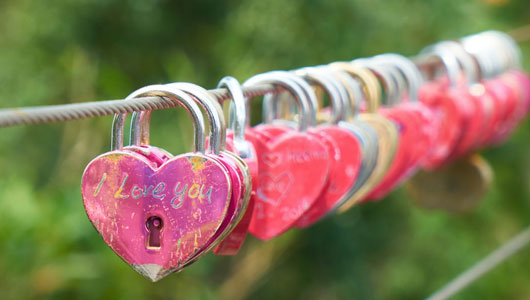
Valentine's Day Traditions
Ask any random group of people to describe Valentine's Day traditions and you're likely to hear these words: chocolates, flowers, cards, romantic dinners out. Before you roll your eyes and groan, "Hallmark holiday," hear us out. At its heart (pun intended), this consumer-focused holiday of cheesy sentiment and mass marketing is truly about love.
Let's take a look at some more interesting — and dare we say, more romantic — Valentine's Day traditions from history, around the world, and right here at home.
Making Handmade Cards
Handmade Valentine's Day cards originated in the Middle Ages in Europe, and were often adorned with ribbons, lace, and ornate calligraphy. Valentine's Day cards of this era might feature drawings of birds, which were believed to choose lifelong mates in mid-February.
Printed Valentine's Day cards appeared in the 1700s, and were typically hand-drawn and colored by artisans. Mass produced cards didn't pop up until around a hundred years later, during the Industrial Revolution.
Motivated to make your own romantic card? Craft stores are perfect places to round up materials, including cardstock, rubber stamps with beautiful patterns, paper lace, stickers, and watercolor paints.
Writing Poetry
You don't have to be Emily Dickinson to pen a few meaningful words to your significant other on Valentine's Day. Instead of relying on a pre-made card to say how you feel, write about a shared memory, an inside joke, or a trait of your partner's that you value.
Did your partner take good care of you while you were sick this year? Do you love their cooking? Do you share a phrase or gesture that no one else would know? Make it part of your Valentine's message, and add depth and intimacy to what is often a bland, commerce-driven holiday.
And of course, if you are a poet, or are otherwise excellent with words, don't hesitate to write an actual poem to your lover on Valentine's Day. For a little inspiration, check out love poems by Pablo Neruda, Maxine Kumin, or Maya Angelou.
Celebrating Your Social Circle
In Japan, women take the initiative on Valentine's Day, gifting chocolate to lovers, friends, and colleagues alike. Honmei-choco — high quality and often homemade "true feeling chocolates" — are delivered by hand to partners or crushes, while Giri-choco — standard "obligation chocolates" — go to colleagues or acquaintances.
In mid-March on White Day, the recipients of Honmei-choco respond in kind by lavishing their beloved with items worth two or three times more than the original gift of chocolate. Lingerie and jewelry are common White Day presents, as are flowers, handbags, and candies. White gifts used to be de rigueur on White Day, but these days, any color goes.
Pressing Flowers
In the United States, fresh flowers are all the rage on Valentine's Day, but not so in Denmark! The Danes didn't celebrate Valentine's as a country until the 1990s, but they've wasted no time making the day their own with unique traditions. These include gifting loved ones with dried, pressed snowdrops, a white flowering bulb native to Europe and the Middle East.
When it comes to V Day, the Danes don't stop with snowdrops! Another tradition is to write what's called a gaekkebrev. This romantic and humorous note is signed with 3 mysterious dots, leaving the recipient to guess who the sender is. A correct guess is rewarded with an Easter egg on Easter, which in Denmark takes place a few weeks after Valentine's Day.
Playing The Hook-Up Lottery
Single and feeling adventurous? Do like the Romans did. Centuries before Hallmark was a thing, the Romans celebrated an early version of Valentine's Day, called Lupercalia. This pagan celebration was a bit more brutish than ours, and involved animal sacrifices and folks roaming naked and drunk through the streets. Interesting, but not likely to go over well these days.
Lupercalia festivities also included a type of hook-up lottery, in which men would draw the names of women from a pot and spend the rest of the holiday (and sometimes beyond, if there was a spark) merry-making with them. Sound a bit one-sided? Most historical accounts assure us the game was all in good fun for everyone involved.
Eating Chocolate in Ghana
It wouldn't be Valentine's Day without chocolate, but in Ghana they go all out. Frustrated by the low consumption of chocolate in a country that is the second biggest producer of cocoa in the world, the government in Ghana proclaimed Valentine's Day National Chocolate Day in an effort to inspire more chocolate consumption by local residents.
Chocolate Day events include sharing your chocolate story ("It all started with a packet of Swiss Miss"), a national cocoa quiz, cocoa time with elementary school students, and the unveiling of a chocolate city. No, the buildings aren't made of chocolate, there's just lots and lots of different kinds of the good stuff there. All aboard, chocolate lovers.
Searching For Signs
Single people in the Middle Ages didn't have online dating, but they did have sage leaves, slices of cake, and cemeteries. Back then, it was said that you could conjure visions of your future fiance by pinning sage leaves to your pillow or sliding a piece of wedding cake under said pillow before sleeping. Some unattached folks dropped letters into a bowl of water, uttered an incantation, and tried to read a name in the letters that floated to the top.
In what feels like a combination of Valentine's Day and Halloween, single people in the Middle Ages were encouraged to visit a cemetery at midnight on February 14th and take note of any omens that might guide them toward the right partner. Sounds like a stretch, maybe, but it's cheaper than a subscription on Tinder!
Breaking Out The Vinegar
Got an ex you want to rebuff? A stage-four clinger who doesn't stand a chance? Help them get the message with a Vinegar Valentine. These Victorian-cards once cost around a penny, and used rhyme and humorous insults to brush off unwanted suitors.
Typically sent anonymously, Vinegar Valentines were cheaply made postcards or sheets of paper illustrated with mocking caricatures of poor Valentine wannabes. Until sometime in the 1840s, the recipient of the Valentine was responsible to pay for postage. Insult to injury, indeed.
